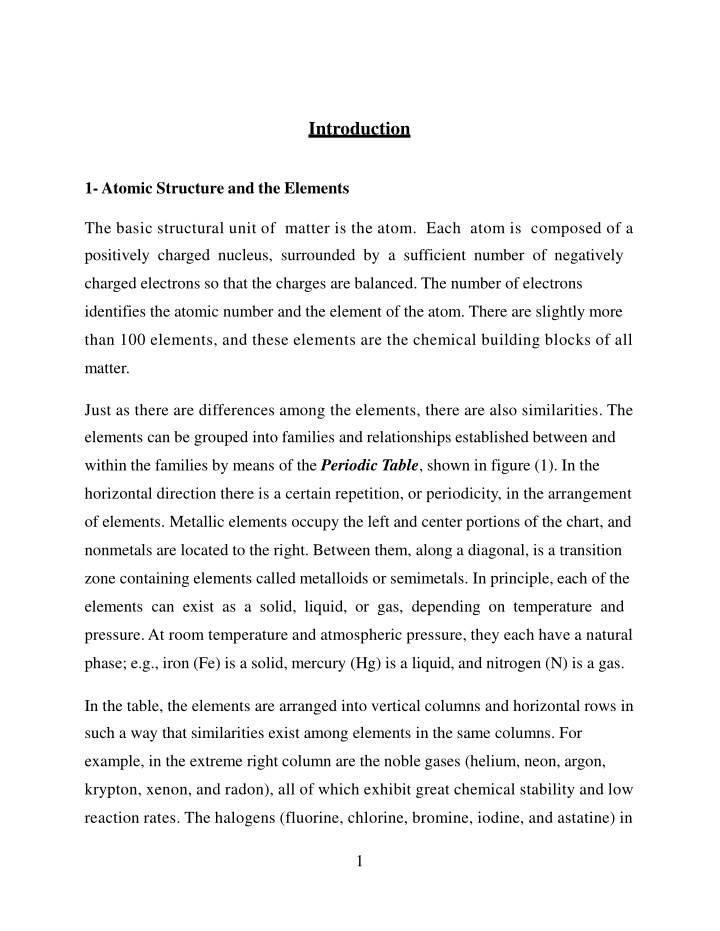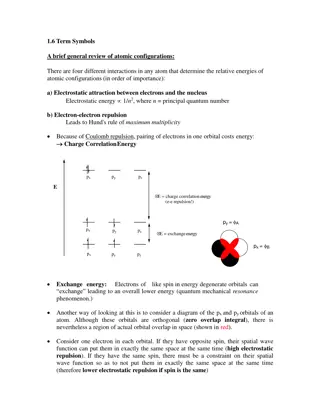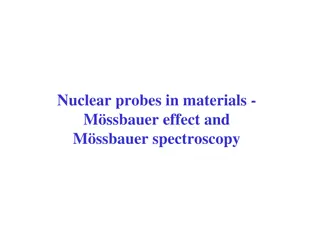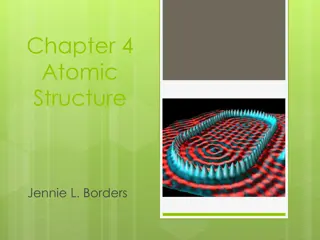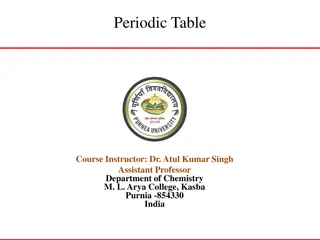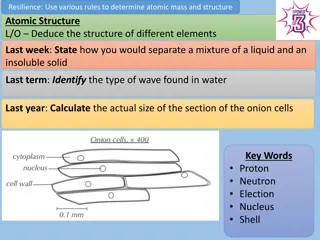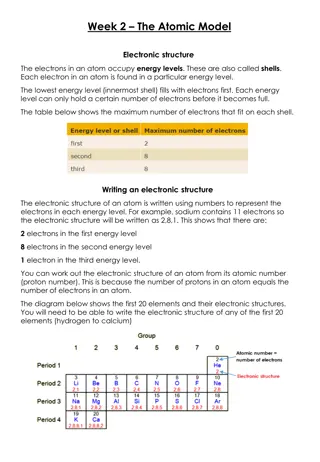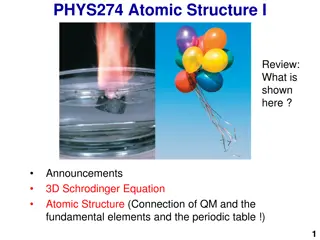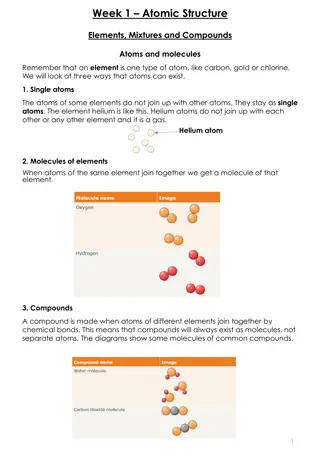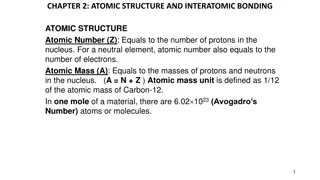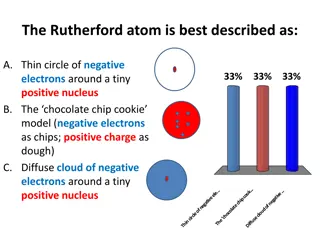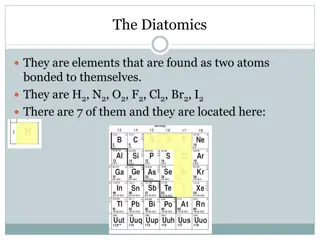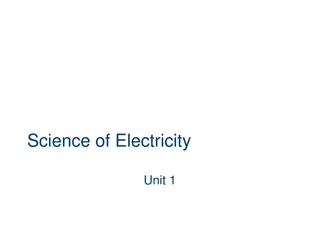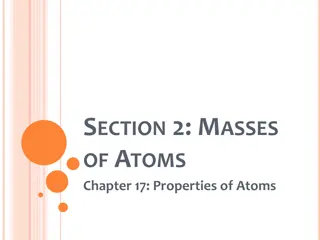Atomic Structure and the Elements Overview
The atom, composed of a nucleus and electrons, forms the basis of all matter. Elements, grouped in families on the Periodic Table, exhibit similarities and differences based on their atomic structures. The arrangement of electrons in orbits determines an atom's chemical properties and reactivity. By understanding the atomic structure, one can grasp how elements interact and form compounds.
Download Presentation

Please find below an Image/Link to download the presentation.
The content on the website is provided AS IS for your information and personal use only. It may not be sold, licensed, or shared on other websites without obtaining consent from the author.If you encounter any issues during the download, it is possible that the publisher has removed the file from their server.
You are allowed to download the files provided on this website for personal or commercial use, subject to the condition that they are used lawfully. All files are the property of their respective owners.
The content on the website is provided AS IS for your information and personal use only. It may not be sold, licensed, or shared on other websites without obtaining consent from the author.
E N D
Presentation Transcript
Introduction 1-Atomic Structure and the Elements The basic structural unit of matter is the atom. Each atom is composed of a positively charged nucleus, surrounded by a sufficient number of negatively charged electrons so that the charges are balanced. The number of electrons identifies the atomic number and the element of the atom. There are slightly more than 100 elements, and these elements are the chemical building blocks of all matter. Just as there are differences among the elements, there are also similarities. The elements can be grouped into families and relationships established between and within the families by means of the Periodic Table, shown in figure (1). In the horizontal direction there is a certain repetition, or periodicity, in the arrangement of elements. Metallic elements occupy the left and center portions of the chart, and nonmetals are located to the right. Between them, along a diagonal, is a transition zone containing elements called metalloids or semimetals. In principle, each of the elements can exist as a solid, liquid, or gas, depending on temperature and pressure.At room temperature and atmospheric pressure, they each have a natural phase; e.g., iron (Fe) is a solid, mercury (Hg) is a liquid, and nitrogen (N) is a gas. In the table, the elements are arranged into vertical columns and horizontal rows in such a way that similarities exist among elements in the same columns. For example, in the extreme right column are the noble gases (helium, neon, argon, krypton, xenon, and radon), all of which exhibit great chemical stability and low reaction rates. The halogens (fluorine, chlorine, bromine, iodine, and astatine) in 1
column VIIA share similar properties (hydrogen is not included among the halogens). The noble metals (copper, silver, and gold) in column IB have similar properties. Generally there are correlations in properties among elements within a given column, whereas differences exist among elements in different columns. Many of the similarities and differences among the elements can be explained by their respective atomic structures. The simplest model of atomic structure, called the planetary model, shows the electrons of the atom orbiting around the nucleus at certain fixed distances, called shells, as shown in Figure (2). The hydrogen atom (atomic number 1) has one electron in the orbit closest to the nucleus. Helium (atomic number 2) has two.Also shown in the figure are the atomic structures for fluorine (atomic number 9), neon (atomic number 10), and sodium (atomic number 11). One might infer from these models that there is a maximum number of electrons that can be contained in a given orbit. This turns out to be correct, and the maximum is defined by: Maximum number of electrons in an orbit = 2n2 where n identifies the orbit, with n = 1 closest to the nucleus. 2
The number of electrons in the outer most shell, relative to the maximum number allowed, determines to a large extent the atom s chemical affinity for other atoms. These outer-shell electrons are called valence electrons. For example, because a hydrogen atom has only one electron in its single orbit, it readily combines with another hydrogen atom to form a hydrogen molecule H2. For the same reason, hydrogen also reacts readily with various other elements (e.g., to form H2O). In the helium atom, the two electrons in its only orbit are the maximum allowed (2 n2= 2(1)2= 2), and so helium is very stable. Neon is stable for the same reason: Its outermost orbit (n=2) has eight electrons (the maximum allowed), so neon is an inert gas. In contrast to neon, fluorine has one fewer electron in its outer shell (n = 2) than the maximum allowed and is readily attracted to other elements that might share an electron to make a more stable set. The sodium atom seems divinely made for the situation, with one electron in its outermost orbit. It reacts strongly with fluorine to form the compound sodium fluoride, as pictured in Figure (3). 4
At the low atomic numbers considered here, the prediction of the number of electrons in the outer orbit is straightforward.As the atomic number increases to higher levels, the allocation of electrons to the different orbits becomes somewhat more complicated. There are rules and guidelines, based on quantum mechanics, that can be used to predict the positions of the electrons among the various orbits and explain their characteristics. 2- Bonding Between Atoms and Molecules Atoms are held together in molecules by various types of bonds that depend on the valence electrons. By comparison, molecules are attracted to each other by weaker bonds, which generally result from the electron configuration in the individual molecules. Thus, we have two types of bonding: (1) primary bonds, generally associated with the formation of molecules; and (2) secondary bonds, generally associated with attraction between molecules. Primary bonds are much stronger than secondary bonds. 2.1 Primary Bonds: primary bonds are characterized by strong atom-to-atom attractions that involve the exchange of valence electrons. Primary bonds include the following forms: (a) ionic, (b) covalent, and (c) metallic, as illustrated in 5
Figure (4). Ionic and covalent bonds are called intramolecular bonds because they involve attractive forces between atoms within the molecule. a- Ionic bond: in the ionic bond, the atoms of one element give up their outer electron(s), which are in turn attracted to the atoms of some other element to increase their electron count in the outermost shell to eight. In general, eight electrons in the outer shell is the most stable atomic configuration (except for the very light atoms), and nature provides a very strong bond between atoms that achieves this configuration. The previous example of the reaction of sodium and fluorine to form sodium fluoride (Figure 3) illustrates this form of atomic bond. Sodium chloride (table salt) is a more common example. Because of the transfer of electrons between the atoms, sodium and fluorine (or sodium and chlorine) ions are formed, from which this bonding derives its name. Properties of solid materials with ionic bonding include low electrical conductivity and poor ductility. b- Covalent bond: the covalent bond is one in which electrons are shared (as opposed to transferred) between atoms in their outermost shells to achieve a stable set of eight. Fluorine and diamond are two examples of covalent bonds. In fluorine, one electron from each of two atoms is shared to form (F2) gas, as shown in Figure 6
(5-a). In the case of diamond, which is carbon (atomic number 6), each atom has four neighbors with which it shares electrons. This produces a very rigid three- dimensional structure, not adequately represented in Figure (5-b), and accounts for the extreme high hardness of this material. Other forms of carbon (e.g., graphite) do not exhibit this rigid atomic structure. c- Metallic bond: the metallic bond is, of course, the atomic bonding mechanism in pure metals and metal alloys.Atoms of the metallic elements generally possess too few electrons in their outermost orbits to complete the outer shells for all of the atoms in, say, a given block of metal. Accordingly, instead of sharing on an atom- to-atom basis, metallic bonding involves the sharing of outer-shell electrons by all atoms to form a general electron cloud that permeates the entire block. This cloud provides the attractive forces to hold the atoms together and forms a strong, rigid structure in most cases. Because of the general sharing of electrons, and their freedom to move within the metal, metallic bonding provides for good electrical conductivity. Other typical properties of materials characterized by metallic bonding include good conduction of heat and good ductility. 7
2.1 Secondary Bonds: Whereas primary bonds involve atom-to-atom attractive forces, secondary bonds involve attraction forces between molecules, or intermolecular forces. There is no transfer or sharing of electrons in secondary bonding, and these bonds are therefore weaker than primary bonds. There are three forms of secondary bonding: (a) dipole forces, (b) London forces, and (c) hydrogen bonding, illustrated in Figure (6). Types (a) and (b) are often referred to as van der Waals forces, after the scientist who first studied and quantified them. a- Dipole forces: dipole forces arise in a molecule comprised of two atoms that have equal and opposite electrical charges. Each molecule therefore forms a dipole, as shown in Figure (6-a) for hydrogen chloride. Although the material is electrically neutral in its aggregate form, on a molecular scale the individual dipoles attract each other, given the proper orientation of positive and negative ends of the molecules. These dipole forces provide a net intermolecular bonding within the material. b- London forces: London forces involve attractive forces between nonpolar molecules; that is, the atoms in the molecule do not form dipoles in the sense of the preceding paragraph. However, owing to the rapid motion of the electrons in orbit around the molecule, temporary dipoles form when more electrons happen to be on one side of the molecule than the other, as suggested by figure (6-b). These 8
instantaneous dipoles provide a force of attraction between molecules in the material. c- Hydrogen bonding: hydrogen bonding occurs in molecules containing hydrogen atoms that are covalently bonded to another atom (e.g., oxygen inH2O). Because the electrons needed to complete the shell of the hydrogen atom are aligned on one side of its nucleus, the opposite side has a net positive charge that attracts the electrons of atoms in neighboring molecules. Hydrogen bonding is illustrated in figure (6-c) for water, and is generally a stronger intermolecular bonding mechanism than the other two forms of secondary bonding. It is important in the formation of many polymers. 3- Crystalline Structure When materials solidify from the molten state, they tend to close ranks and pack tightly, in many cases arranging themselves into a very orderly structure, and in other cases, not quite so orderly. Two fundamentally different material structures can be distinguished: (1) crystalline and (2) noncrystalline. Many materials form into crystals on solidification from the molten or liquid state. It is characteristic of virtually all metals, as well as many ceramics and polymers. A crystalline structure is one in which the atoms are located at regular and recurring positions in three dimensions. The pattern may be replicated millions of times within a given crystal. The structure can be viewed in the form of a unit cell, which is the basic geometric grouping of atoms that is repeated. To illustrate, consider the unit cell for the body-centered cubic (BCC) crystal structure shown in figure (7), one of the common structures found in metals. The simplest model of the BCC unit cell is illustrated in figure (7-a).Although this model clearly depicts 9
the locations of the atoms within the cell, it does not indicate the close packing of the atoms that occurs in the real crystal, as in Figure (7-b). Figure (7-c) shows the repeating nature of the unit cell within the crystal. In metals, three lattice structures are common: (1) body-centered cubic (BCC), (2) face centered cubic (FCC), and (3) hexagonal close-packed (HCP), illustrated in figure (8). Crystal structures for the common metals are presented in table (1). Note that some metals undergo a change of structure at different temperatures. Iron, for example, is BCC at room temperature; it changes to FCC above 912 C and back to BCC at temperatures above 1400 C. When a metal (or other material) changes structure like this, it is referred to as being allotropic. 10
